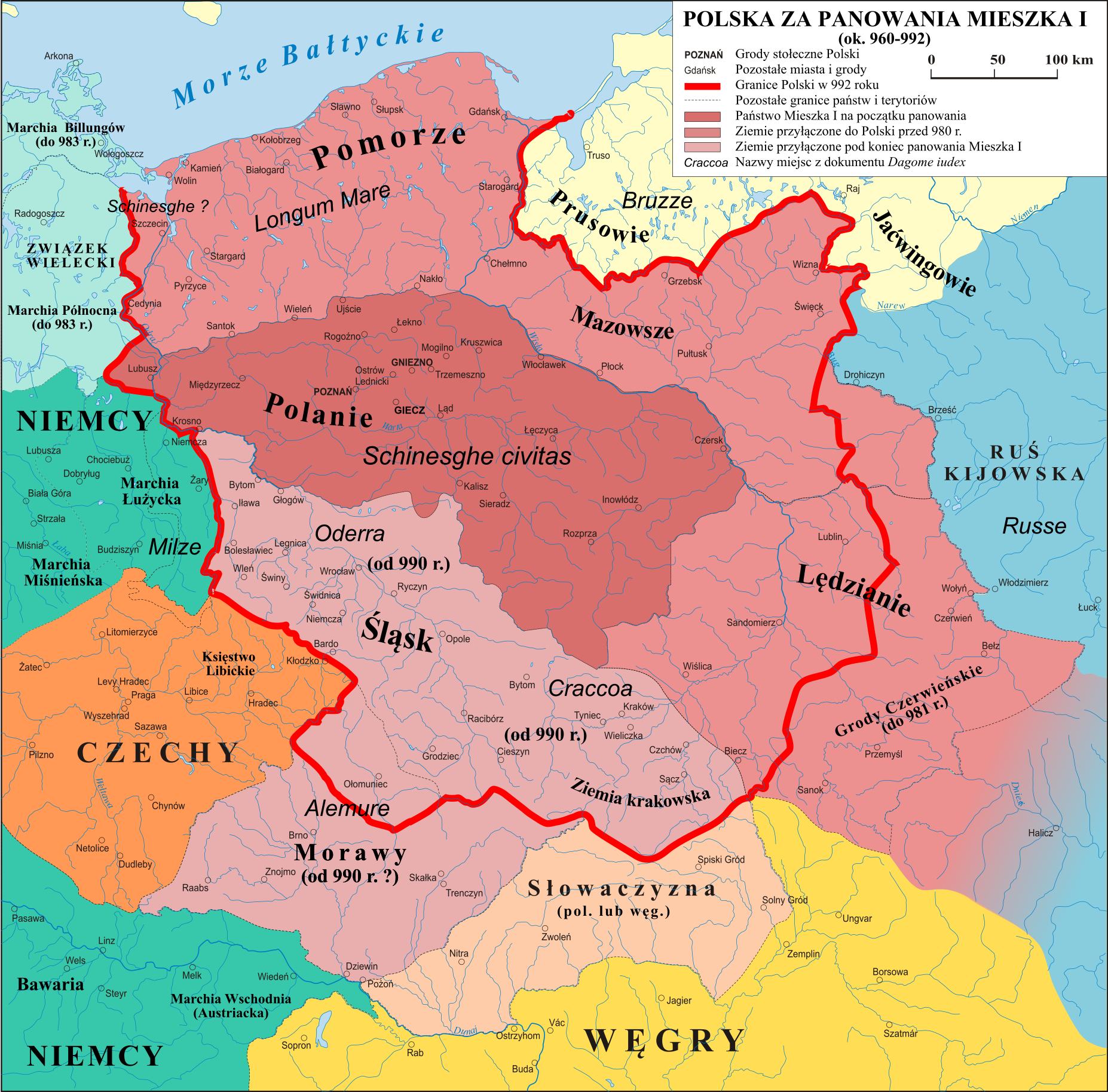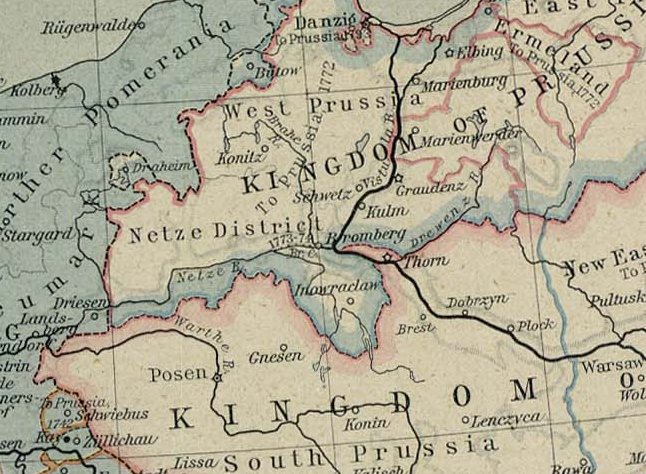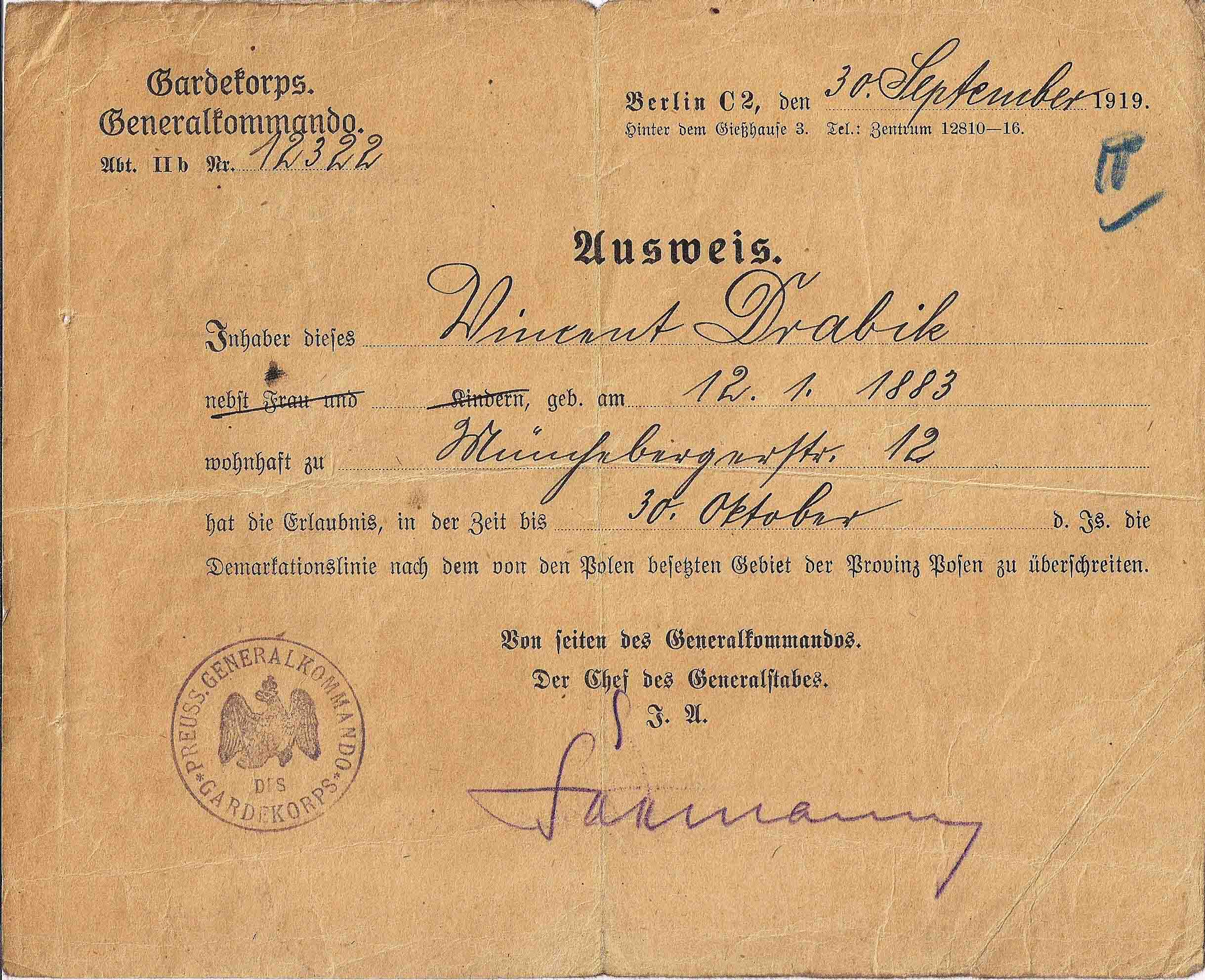|
Province Of West Prussia
The Province of West Prussia (german: Provinz Westpreußen; csb, Zôpadné Prësë; pl, Prusy Zachodnie) was a Provinces of Prussia, province of Prussia from 1773 to 1829 and 1878 to 1920. West Prussia was established as a province of the Kingdom of Prussia in 1773, formed from Royal Prussia of the Polish–Lithuanian Commonwealth annexed in the First Partition of Poland. West Prussia was dissolved in 1829 and merged with East Prussia to form the Province of Prussia, but was re-established in 1878 when the merger was reversed and became part of the German Empire. From 1918, West Prussia was a province of the Free State of Prussia within Weimar Germany, losing most of its territory to the Second Polish Republic and the Free City of Danzig in the Treaty of Versailles. West Prussia was dissolved in 1920, and its remaining western territory was merged with Province of Posen, Posen to form Posen-West Prussia, and its eastern territory merged with East Prussia as the Marienwerder (re ... [...More Info...] [...Related Items...] OR: [Wikipedia] [Google] [Baidu] |
Historical Regions Of Central Europe
There are many historical regions of Central Europe. For the purpose of this list, Central Europe is defined as the area contained roughly within the south coast of the Baltic Sea, the Elbe River, the Alps, the Danube River, the Black Sea and the Dnepr River. These historical regions were current in different time periods – from medieval to modern era – and may often overlap. National borders have been redrawn across those regions many times over the centuries, so usually a historical region cannot be assigned to any specific nation. The list below indicates which present-day states control the whole or a part of each of the listed regions. Former Austro-Hungarian empire *Cisleithania *Transleithania *''For Bosnia and Herzegonvina, please refer to these two articles:'' **Austro-Hungarian rule in Bosnia and Herzegovina **Regions of Bosnia and Herzegovina The kingdoms and lands represented in the Austrian Imperial Council (Cisleithania) Lands of the Crown of Saint Stephen (K ... [...More Info...] [...Related Items...] OR: [Wikipedia] [Google] [Baidu] |
East Prussia
East Prussia ; german: Ostpreißen, label=Low Prussian; pl, Prusy Wschodnie; lt, Rytų Prūsija was a province of the Kingdom of Prussia from 1773 to 1829 and again from 1878 (with the Kingdom itself being part of the German Empire from 1871); following World War I it formed part of the Weimar Republic's Free State of Prussia, until 1945. Its capital city was Königsberg (present-day Kaliningrad). East Prussia was the main part of the region of Prussia along the southeastern Baltic Coast. The bulk of the ancestral lands of the Baltic Old Prussians were enclosed within East Prussia. During the 13th century, the native Prussians were conquered by the crusading Teutonic Knights. After the conquest the indigenous Balts were gradually converted to Christianity. Because of Germanization and colonisation over the following centuries, Germans became the dominant ethnic group, while Masurians and Lithuanians formed minorities. From the 13th century, East Prussia was part of the mon ... [...More Info...] [...Related Items...] OR: [Wikipedia] [Google] [Baidu] |
Old Prussians
Old Prussians, Baltic Prussians or simply Prussians (Old Prussian: ''prūsai''; german: Pruzzen or ''Prußen''; la, Pruteni; lv, prūši; lt, prūsai; pl, Prusowie; csb, Prësowié) were an indigenous tribe among the Baltic peoples that inhabited the region of Prussia, at the south-eastern shore of the Baltic Sea between the Vistula Lagoon to the west and the Curonian Lagoon to the east. The Old Prussians, who spoke an Indo-European language now known as Old Prussian and worshipped pre-Christian deities, lent their name, despite very few commonalities, to the later, predominantly Low German-speaking inhabitants of the region. The duchy of the Polans under Mieszko I, which was the predecessor of the Kingdom of Poland, first attempted to conquer and baptize the Baltic tribes during the 10th century, but repeatedly encountered strong resistance. Not until the 13th century were the Old Prussians subjugated and their lands conquered by the Teutonic Order. The remaining Old Prus ... [...More Info...] [...Related Items...] OR: [Wikipedia] [Google] [Baidu] |
Masovians
Masovians, also spelled as Mazovians, and historically known as Masurians, is an ethnographic group of Polish people that originate from the region of Masovia, located mostly within borders of the Masovian Voivodeship, Poland. They speak the Masovian dialect dialect of Polish.G. Odoj, A. Peć: ''Dziedzictwo kulturowe – edukacja regionalna''. Dzierżoniów: Wydawnictwo Alex, 2000, p. 74, ISBN 83-85589-35-X, OCLC 749376082. The group originate from the Lechitic tribe of Masovians, first referenced in the historical records by Nestor the Chronicler in the 11th century. Name The name Masovian, in Polish, ''Mazowszanin'', comes from the name of the region of Masovia, in Polish known as ''Mazowsze''. The name of the region, comes from its Old Polish names ''Mazow'', and ''Mazosze'', and most likely came from word ''maz'' (ancestory word of modern ''maź'' and ''mazać''), which was used to either describe a "''muddy region''" or a "''person covered in mud''". Historically, prior t ... [...More Info...] [...Related Items...] OR: [Wikipedia] [Google] [Baidu] |
Pomerelia
Pomerelia,, la, Pomerellia, Pomerania, pl, Pomerelia (rarely used) also known as Eastern Pomerania,, csb, Pòrénkòwô Pòmòrskô Vistula Pomerania, prior to World War II also known as Polish Pomerania, is a historical sub-region of Pomerania on the southern shore of the Baltic Sea. The designation of Gdańsk Pomerania, is largely coextensive with Pomerelia, but slightly narrower, as it does not cover the Chełmno Land (including the Michałów Land). Its largest and most important city is Gdańsk. Since 1999, the region has formed the core of the Pomeranian Voivodeship. Overview Pomerelia is located in northern Poland west of the Vistula river and east of the Łeba river, mostly within the Pomeranian Voivodeship, with southern part located in the Kuyavian-Pomeranian Voivodeship and small parts in West Pomeranian Voivodeship. It has traditionally been divided into Kashubia, Kociewie, Tuchola Forest and Chełmno Land (including the Michałów Land, sometimes with the add ... [...More Info...] [...Related Items...] OR: [Wikipedia] [Google] [Baidu] |
Pomeranians (Slavic Tribe)
The Pomeranians (german: Pomoranen; csb, Pòmòrzónie; pl, Pomorzanie), first mentioned as such in the 10th century, were a West Slavic tribe, which since the 5th to the 6th centuries had settled at the shore of the Baltic Sea between the mouths of the Oder and Vistula Rivers (the latter Farther Pomerania and Pomerelia). They spoke the Pomeranian language that belonged to the Lechitic languages, a branch of the West Slavic language family. The name ''Pomerania'' has its origin in the Old Polish ''po more'', which means "Land at the Sea". Prehistory Following the exit of the Hamburgian hunters, the area was inhabited successively by Celts and the Wielbark Culture (Germanic tribes similar to the Goths and the Rugians). Groups of Slavs populated the area as a result of the Slavic migration. The Pomeranian tribes formed around the 6th century. There was also a Pomeranian culture, which was replaced by the Jastorf culture. From around the 6th century, West Slavic tribes mig ... [...More Info...] [...Related Items...] OR: [Wikipedia] [Google] [Baidu] |
Lechites
Lechites (, german: Lechiten), also known as the Lechitic tribes (, german: Lechitische Stämme), is a name given to certain West Slavic tribes who inhabited modern-day Poland and eastern Germany, and were speakers of the Lechitic languages. Distinct from the Czech–Slovak subgroup, they are the closest ancestors of ethnic Poles and the Pomeranians, Lusatians and Polabians. History According to Polish legend, Mieszko I inherited the ducal throne from his father who probably ruled over two-thirds of the territory inhabited by eastern Lechite tribes. He united the Lechites east of the Oder (Polans, Masovians, Pomeranians, Vistulans, Silesians) into a single country of Poland. His son, Bolesław I the Brave, founded the bishoprics at Wrocław, Kołobrzeg, and Kraków, and an archbishopric at Gniezno. Bolesław carried out successful wars against Bohemia, Moravia, Kievan Rus' and Lusatia, and forced the western Pomeranians to pay Poland a tribute. Shortly before his death Bo ... [...More Info...] [...Related Items...] OR: [Wikipedia] [Google] [Baidu] |
Middle Ages
In the history of Europe, the Middle Ages or medieval period lasted approximately from the late 5th to the late 15th centuries, similar to the post-classical period of global history. It began with the fall of the Western Roman Empire and transitioned into the Renaissance and the Age of Discovery. The Middle Ages is the middle period of the three traditional divisions of Western history: classical antiquity, the medieval period, and the modern period. The medieval period is itself subdivided into the Early, High, and Late Middle Ages. Population decline, counterurbanisation, the collapse of centralized authority, invasions, and mass migrations of tribes, which had begun in late antiquity, continued into the Early Middle Ages. The large-scale movements of the Migration Period, including various Germanic peoples, formed new kingdoms in what remained of the Western Roman Empire. In the 7th century, North Africa and the Middle East—most recently part of the Eastern Ro ... [...More Info...] [...Related Items...] OR: [Wikipedia] [Google] [Baidu] |
Posen-West Prussia
The Frontier March of Posen-West Prussia (german: Grenzmark Posen-Westpreußen, pl, Marchia Graniczna Poznańsko-Zachodniopruska) was a province of Prussia from 1922 to 1938. Posen-West Prussia was established in 1922 as a province of the Free State of Prussia within Weimar Germany, formed from merging three remaining non-contiguous territories of Posen and West Prussia, which had lost the majority of their territory to the Second Polish Republic and Free City of Danzig in the Treaty of Versailles. From 1934, Posen-West Prussia was ''de facto'' ruled by Brandenburg until it was dissolved by Nazi Germany, effective 1 October 1938 and its territory divided between the Prussian provinces of Pomerania, Brandenburg and Silesia. Schneidemühl (present-day Piła) was the provincial capital. Today, the province is entirely contained within the modern state of Poland. Background Until the late 18th century partitions of Poland, the lands which made up Posen-West Prussia had been ... [...More Info...] [...Related Items...] OR: [Wikipedia] [Google] [Baidu] |
Province Of Posen
The Province of Posen (german: Provinz Posen, pl, Prowincja Poznańska) was a province of the Kingdom of Prussia from 1848 to 1920. Posen was established in 1848 following the Greater Poland Uprising as a successor to the Grand Duchy of Posen, which in turn was annexed by Prussia in 1815 from Napoleon's Duchy of Warsaw. It became part of the German Empire in 1871. After World War I, Posen was briefly part of the Free State of Prussia within Weimar Germany, but was dissolved in 1920 when most of its territory was ceded to the Second Polish Republic by the Treaty of Versailles, and the remaining German territory was later re-organized into Posen-West Prussia in 1922. Posen (present-day Poznań, Poland) was the provincial capital. Geography The land is mostly flat, drained by two major watershed systems; the Noteć (German: ''Netze'') in the north and the Warta (''Warthe'') in the center. Ice Age glaciers left moraine deposits and the land is speckled with hundreds of "finger l ... [...More Info...] [...Related Items...] OR: [Wikipedia] [Google] [Baidu] |
Free City Of Danzig
The Free City of Danzig (german: Freie Stadt Danzig; pl, Wolne Miasto Gdańsk; csb, Wòlny Gard Gduńsk) was a city-state under the protection of the League of Nations between 1920 and 1939, consisting of the Baltic Sea port of Danzig (now Gdańsk, Poland) and nearly 200 other small localities in the surrounding areas. Overview The polity was created on 15 November 1920 in accordance with the terms of Article 100 (Section XI of Part III) of the 1919 Treaty of Versailles after the end of World War I. In line with the treaty provisions, the entity was established under the oversight of the League of Nations. Although predominantly German-populated, the territory was bound by the imposed union with Poland covering foreign policy, defence, customs, railways and post, while remaining distinct from both the post-war German Republic and the newly independent Polish Republic. In addition, Poland was given certain rights pertaining to port facilities in the city. In the 1920 Const ... [...More Info...] [...Related Items...] OR: [Wikipedia] [Google] [Baidu] |







